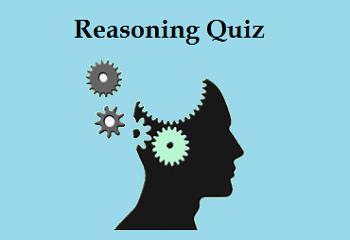Hello Aspirants. Welcome to Online Reasoning Section in AffairsCloud.com. Here we are creating question sample in coded Inequalities, which is common for all the competitive exams. We have included Some questions that are repeatedly asked in bank exams !!
Directions (1 – 5): In the following questions, the symbols * , $, #, δ and % are used with the following meaning as illustrated below:
‘A $ B’ means ‘A is neither greater than nor smaller than B’.
‘A δ B’ means ‘A is neither greater than nor equal to B’.
‘A % B’ means ‘A is neither smaller than nor equal to B’.
‘A * B’ means ‘A is not smaller than B’.
‘A # B’ means ‘A is not greater than B’.
Now in each of the following question assuming the given statements to be true, find which of the conclusions I, II, III and IV given below them is/are definitely true and give your answer accordingly.
- Statements: Q $ J, J δ Y, Y * L, L # W
Conclusions:
I. W % Y
II. L δ J
III. L # Q
IV. Q δ W
A) None is true
B) Only I is true
C) Only II is true
D) Only III is true
E) Only IV is trueA) None is true
Explanation:
Q = J < Y ≥ L ≤ W - Statements: P * L, L % T, T δ R, R # N
Conclusions:
I. N % T
II. P %T
III. R % L
IV. N # P
A) Only I is true
B) Only II is true
C) Only I and II are true
D) Only II and III are true
E) None of theseC) Only I and II are true
Explanation:
P ≥ L > T < R ≤ N - Statements: F δ Q, Q $ V, V % B, B * P
Conclusions:
I. F δ B
II. P δ V
III. V % F
IV. Q%P
A) Only I is true
B) Only I, II and III are true
C) Only I, II and IV are true
D) Only II, III and IV are true
E) None of theseD) Only II, III and IV are true
Explanation:
F < Q = V > B ≥ P - Statements: Q % N, N # K, K $ P, P δ R
Conclusions:
I. P $ N
II. P % N
III. R % N
IV. Q % P
A) Only either I or II and III are true
B) Only either I or II is true
C) Only either I or II and III and IV are true
D) Only III is true
E) None of theseA) Only either I or II and III are true
Explanation:
Q > N ≤ K = P < R - Statements: E # K, K $ T, P % T, V * P
Conclusions:
I. T * E
II. P % K
III. P % E
IV. V % K
A) Only I and II are true
B) Only I, II and III are true
C) Only II and III are true
D) Only II, III and IV are true
E) All are trueE) All are true
Explanation:
E ≤ K = T < P ≤ V
Directions (6-10): In all the questions that follow, relationship between different elements is shown in the statements. The statements are followed by two conclusions. Give answer accordingly.
(A) only 1st follows
(B) only 2nd follows
(C) either 1st or 2nd
(D) neither 1st nor 2nd
(E) both 1st and 2nd
- Statements: A > B ≤ F = C, F ≤ P ≤ T, C ≤ D
Conclusions:
I. T > D
II. D ≥ T(C) either 1st or 2nd
Explanation:
T ≥ F = C ≤ D, this gives both T and D less than equal to F
So either T will be > D or T will be ≤ D - Statements: P > Q ≥ R, T = R ≤ A, A ≥ B
Conclusions:
I. B < P
II. P ≤ B(C) either 1st or 2nd
Explanation:
B ≤ A ≥R < P so both are false - Statements: T > A < B ≤ C, Q ≤ L ≤ A, G < L
Conclusions:
I. C > G
II. Q < T(E) both 1st and 2nd
Explanation:
C > A ≥ L > G, so C > G
Q ≤ A < T, so Q < T - Statements: P > Q, Q < M, M ≥ A
Conclusions:
I. A < Q II. P > M(D) neither 1st nor 2nd
Explanation:
A ≤ M > Q, so no relationship between A and Q
P > Q < M, both P and M less than Q so no relationship between P and M - Statements: D ≥ B ≥ J, S < P, P > E
Conclusions:
I. E > B
II. D > P(D) neither 1st nor 2nd
Explanation:
E < P > S ≤ B, so relation cant be determined between E and B
D ≥ S < P, so relation cant be determined between D and P



